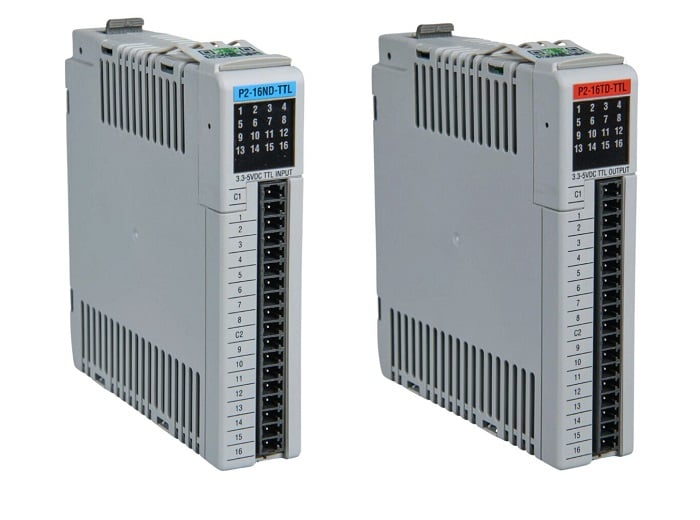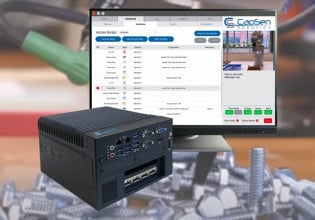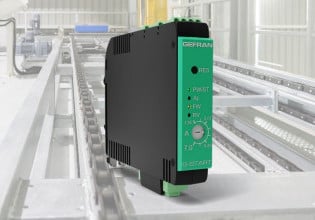New I/O Modules for AutomationDirect’s Productivity PLC Series
The new additions include a high-current relay output for the Productivity1000 and 2000 series and a TTL input and output for the Productivity2000, allowing interface with systems of varying voltages.
AutomationDirect has recently announced a set of new modules for the popular Productivity1000 and Productivity2000 PLC series, designed to allow interface with systems of higher and lower and even AC voltages.
The new products include one module for the Productivity1000 series: a high-current relay output that includes 4x individually isolated relays with wiring access to both the NO and NC output contacts.
There are three new models to bolster the Productivity2000 series. These modules include a similar relay output, but the P2000 device includes 6x relay channels, with only one of them providing access to the NC contact. In addition, there is a 16-channel TTL input and output module available.

New modules for AutomationDirect’s Productivity1000 and Productivity2000 PLCs. Image (modified) used courtesy of AutomationDirect
High-Current Relay Outputs
If PLCs were intended to replace relay control systems (as was indeed one of their original purposes), then what purpose does it serve incorporating relays into PLCs? Two main reasons: high current rating and different voltage tolerance.
Relay Current
Solid-state devices, like the transistors used in a digital I/O module, still retain some resistance when energized. This converts to power dissipation while passing current. More current means more power loss and heat, so the allowable current is limited.
Relays, on the other hand, use electromechanical contact sets that can withstand a much higher current for power-hungry devices.
For the P1000 series output (P1-04TRS) and the P2000 series output (P2-06TRS), the current tolerance is 7 amps per channel. The P1 model has 4 isolated relays, each with a COM, NO, and NC terminal familiar to all mechanical relays. The P2 model uses 6 isolated relays, each providing access to the COM and NO terminals, while one channel does allow the NC connection.

Relay modules provide an interface for various voltage types and levels. Image (modified) used courtesy of AutomationDirect
Isolated for Voltage Variance
Why is the word ‘isolated’ used when describing some relay outputs? For digital modules, the supply voltage is distributed to all of the output terminals, so all field devices receive the same voltage. One strength of relays is the ability to handle higher/lower voltages or a combination of AC and DC waveforms.
If all the relays in the module allow connection to a unique common (COM) terminal, one module can mix and match multiple voltage levels and types, providing much more flexibility!
- Please exercise caution in these circumstances. Since conductors carrying AC and DC in adjacent wires can introduce interference, make sure you understand the purpose of each signal before designing a new system.
What Does TTL Mean to PLCs?
To a digital electronics expert, TTL refers to transistor-transistor logic that has long been used in PCB-level logic gate ICs, usually working with voltages between 3.3 and 5 volts.
Fortunately, in a PLC, the definition is identical. These modules are helpful for interfacing with board-level devices, usually motor drive controls or microprocessors, which use these 3.3-5 volt levels and cannot be connected to the typical industrial 24-volt systems.
If your facility has relied on relays to interface between PLCs and microcontrollers (even popular boards like Raspberry Pi or Arduino variants), these new 16-channel TTL input and output modules will allow more connections and have a much faster response time than relay signals.

Transistor-transistor logic (TTL) can easily interface with microcontrollers and other discrete process devices. Image (modified) used courtesy of AutomationDirect
These modules are only available for the Productivity2000 PLC series; the 16-channel TTL input (P2-16ND-TTL) allows a 3.3-5 volt input range, while the 16-channel TTL output (P2-16TD-TTL) provides only 5 volts as an output. If you wish to interface with a 3.3 input voltage device, you should consider using a logic level shifter to prevent damage.
New Modules for Various Voltages
AutomationDirect’s Productivity PLCs are a popular choice among manufacturers. The new relay and TTL I/O modules for these PLCs provide new methods of interfacing with external control and field devices, reducing the need for control engineers to purchase and install external conversion devices for complex projects.
New to AutomationDirect PLCs?
We have some tutorials to get you started with Productivity PLC wiring and programming so you can dive in right away!
- Simple Programming with AutomationDirect Productivity PLCs
- Analog I/O with AutomationDirect Productivity PLCs
- Tutorial: Arduino and AutomationDirect Merged in the ProOpen PLC






